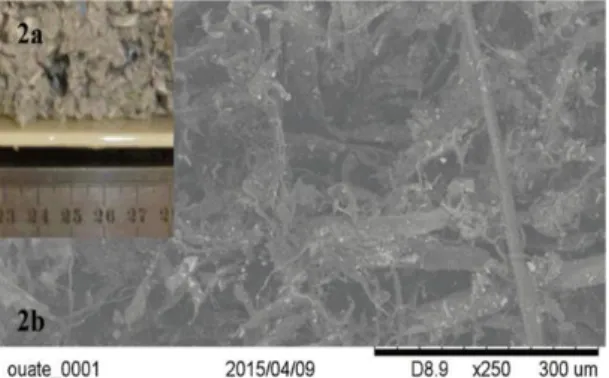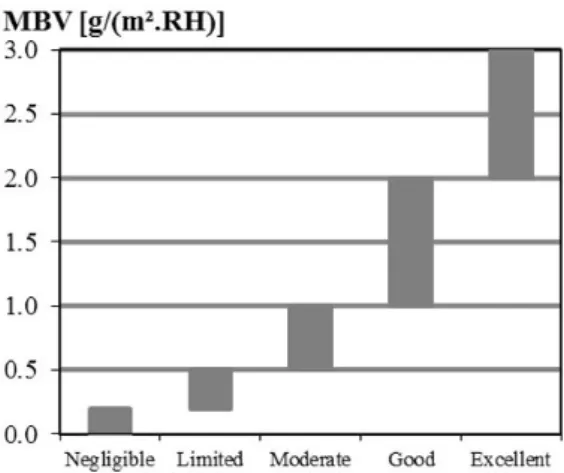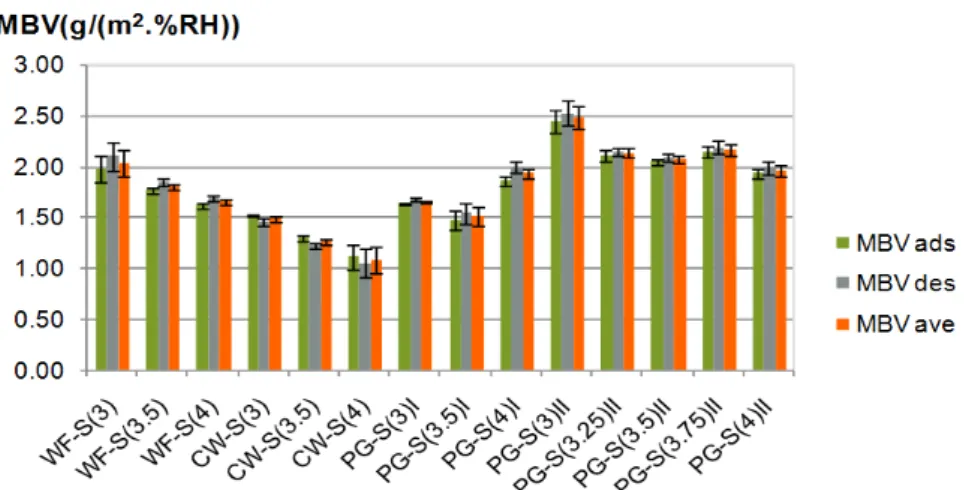EcoGRAFI
2nd International Conference on Bio-based Building Materials & 1st Conference on ECOlogical valorisation of GRAnular and FIbrous materials June 21th - 23th 2017
Clermont-Ferrand, France
HYGRIC AND THERMAL CHARACTERIZATION OF COMPOSITES COUPLING
RECYCLED OR RAW BIO-BASED MATERIALS AND STARCH
L. M. Thieblesson1,2, F. Collet*1, S. Prétot1, C. Lanos1, H. Kouakou2, O.Boffoue2 1 Laboratory of civil engineering and mechanical engineering, Université de Rennes 1, France 2 STRM, Laboratory of Geomaterials, University of Félix Houphouët, Boigny of Cocody, Abidjan, Côte d’Ivoire
*Corresponding author; e-mail: florence.collet@univ-rennes1
Abstract
This study aims to design cheap and environmentally friendly materials well suited for ceiling or interior walls of buildings. This project focuses on valorization of raw materials available in Ivory Coast. Developed composites are realized with eco-materials issued from local recycled or bio-based materials: recycled paper (granules or cellulose wadding) and wood fiber. Aggregates or fibers are bonded with starch. This study investigates several water to starch ratio for each kind of load and two loads to binder ratio are also considered for paper granules. After production, hygric and thermal characterization of the composites is performed. At dry state, the densities of produced composites range from 300 to 600 kg/m3 and thermal conductivities range from 0.09 to
0.17 W/m/K. Moisture buffer values of the composites are measured as defined in the Nordtest protocol. All composites are at least good hygric regulators according the Nordtest project classification. When the paper granule content increases, the composites reach excellent hygric regulator levels whereas their thermal conductivities increase.
Keywords:
Paper granule; Wood fiber; Cellulose wadding; Starch; Thermal characterization; Hygric characterization
1 INTRODUCTION
In a context of sustainable development, green buildings aim at reducing the environmental impacts of buildings while also ensuring high indoor quality (comfortable and healthy). In this case, the choice of raw materials is a decisive factor in the life cycle assessment of the product. The entire stages involved in the production, use and end-of-life of a product must also be achieved with fewer transfers of pollution from one site to another and from one stage to another [Langlois 2013]. These raw materials must contribute to reduce the impact in terms of depletion of natural resources and must offer new strategies to solve energy problems while ensuring high indoor comfort. Bio-based or recycled raw materials may allow to achieve these objectives. This study investigates the feasibility and characterizes composites made of eco-friendly raw materials and designed to make suspended ceilings or interior partition walls. This work is the result of a partnership between the Laboratory of civil engineering and mechanical engineering (Rennes, France) and the Laboratory of Geomaterials (Abidjan, Ivory Coast).
Chosen loads are wood fiber and recycled paper (cellulose wadding or paper granule stemmed from waste paper).
Wood fiber is a bio-based material available in the market as insulation panels of thermal conductivity around 0.04 W/(m.K) and apparent density of 110 kg/m3.
Cellulose wadding is obtained from newspaper’s recycling and is mainly used in bulk. This material is easily available in France for insulation. Hurtado et al [Hurtado 2016] have investigated the properties of cellulose fiber insulation. They show that the cellulose fibers are naturally hygroscopic and that moisture absorption affects thermal conductivity values: thermal conductivity of cellulose fibers increased by 15% for a moisture gain of 10%. Nowadays, paper recycling route is not well established in Ivory Coast and using paper granules as raw material to produce construction materials could be an interesting solution. Paper granules production already exist in Europe but is mainly used for animal bedding [Pettex]. Some products made of plaster with recycled paper already exist [ATE-03/0050], [Armstrong]. They are often studied on acoustical and fireproofing point of view [Yeon 2014]. In this study, the chosen binder is starch. It is considered as one of the promising biodegradable plastic, because of its nature and its low cost. It can be used as binder to produce composites with bio-aggregates. composites made of hemp and starch are developed by Tran le [Tran Le 2014] and
ICBBM& ECOGRAFI 2017 Umurigirwa [Umurigirwa 2010]. In this study, the
composites are done with potato starch which is more available in France. It also shows properties similar to these of cassava starch that is the most available in Ivory Coast.
This study investigates first the feasibility of such composites. For all types of load, several water to binder ratios are considered with one load to binder ratio. A higher load to binder ratio is also investigated for paper granules.
Hygrothermal properties of the produced composites are studied. The characterization is based on the measurements of thermal conductivity and of Moisture Buffer Value which characterizes hygric behavior under dynamic conditions.
2 MATERIALS
2.1 Loads
The raw materials used in this study are wood fiber (WF), cellulose wadding (CW) and paper granules (PG). The wood fibers (WF) used for this work come from industrial panels produced by Steico in France. They are generally used as thermal insulation. These fibers are flame retarded with ammonium phosphate. These panels are carded before use. Scanning Electron Microscope (SEM) observation shows hollow fibers of 20 to 50 μm (Fig.1).
Fig. 1: Wood fiber: 1a) Wood fiber panel 1b) Carded fibers 1c) SEM view.
Cellulose wadding (CW) is a thermal and acoustic insulation produced by Soprema (France) from recycling of newspapers. The cellulose wadding is treated with boron salt to make it flame retardant. Observed at the SEM, it shows a loose tangle of fibers of 15 to 45 μm (Fig. 2).
Paper granules (PG) are produced from paper recycling as paper waste are not managed in Ivory Coast nowadays. Several processing steps are undergone. The paper is first shredded into strips and soaked in water. It is then reduced to a paste with a hand blender and then the water is pressed out. This paste is then crumbled on a 3 mm square mesh sieve. The obtained paper granules are dried in an oven at 40°C. These paper granules, as seen in the SEM, show a compact entanglement of 15 μm wide fibers (Fig. 3).
Fig. 2: 2a) Cellulose wadding 2b) SEM view.
Fig. 3: Paper granules: 3a) strips of paper; 3b) mixing; 3c) paper granules; 3d) SEM view.
2.2 Binder
For this study, the used starch is potato starch sold by Roquette France (Fig. 4). The starch is used in the form of gel. The gelatinization of starch is obtained by heating the starch grains to high enough temperature (> 70 ° C) in the presence of excess water: the water penetrates and swells the grains.
a b
Fig. 4: a) starch powder; b) starch gel.
2.3 Formulation and production of composites Various kinds of composites are produced. They are identified by their type of load (WB, CW or PG), binder (S) and water to binder ratio in bracket. To avoid the binder and the load competing for water, the starch is gelatinized first. Three water to starch ratios are considered: 3, 3.5 and 4. The gel is mixed for a few minutes and the load is then added gradually. The amount of load is chosen in order to ensure a good consistency of the mixture. For all kind of load, the load to starch ratio is 1.5. For paper granules, a higher paper granule to starch ratio is also considered (4.17). The samples are then produced by molding in 28×23×7 cm3 molds. The
mixture is then compacted under a pressure of 0.03 MPa (Fig. 5). After compaction, the samples are immediately removed from the mold and placed in an oven at 40 ° C for drying and in order to avoid the growth of mold. The specimens are weighed regularly until stabilization (0.01% of mass variation per 24 hours).
Fig. 5: Production process: a) Binder mixing; b) Addition of the load; c) Mixing; d) Compaction.
After the measurements of the densities, the specimens are cut into four. The characterizationis performed on 14×12×7 cm3 specimens (Fig.6).
Fig.6: Specimens a) WF-S, b) CW-S, c) PG-S.
3 CHARACTERSATION METHODS
3.1 Thermal characterization
The thermal characterization is based on the measurement of the thermal conductivity after stabilization of the composites at 20 ° C dry state. The thermal conductivity λ (W / (m.K)) is measured using a CT-meter connected to a 5 cm long hot wire (Fig.8). The samples are kept in a dessicator during all measurements (Fig.7).
Fig.7: Measurement of thermal conductivity.
Fig.8: Composites in dessicator.
The measurement is based on the analysis of the rise in temperature as a function of the heating time. The heat flux and the heating time are chosen to achieve a sufficient temperature rise (> 10 °C) and a high correlation coefficient (R2) between the
experimental data (Fig.9) and the theoretical curve (1).
t
K
q
T
ln
4
q is the heat flux per meter (W/m) K is a constant that includes the thermal diffusivity of the material. According to the manufacturer, the hot wire is suitable for measuring the thermal conductivity from 0.02 to 5 W/(m.K) and the expected accuracy is 5%. In this study, the heating time is 120 s and the heat flux varies from 4.1 to 11.4 W/m.
Fig. 9: Example of thermogram ∆T= f (t).
3.2 Hygric characterization
The hygric characterization is based on the measurement of the moisture buffer value (MBV) which quantifies the moisture buffering ability of a material. It is measured under dynamic conditions according to the method defined in the NORDTEST project [Rode 2005]. This value relates the amount of moisture uptake (and release), per open surface area, under daily cyclic variation of relative humidity according to (2).
RH
highRH
low
A
m
MBV
.
MBV: moisture buffer value (kg/(m2%RH)), ∆m:
moisture uptake/release during the period (kg), A: open surface area (m2), RHhigh/low: high/low relative
humidity level (%).
The test method requires prismatic specimens to be sealed on five out of six sides. After stabilization at (23°C; 50%RH), specimens are exposed to daily cyclic variations: 8 h at high relative humidity (75%) followed by 16 h at low relative humidity (33%). Stability is reached when the change in mass is the same between the last three cycles with a discrepancy lower than 5%.
Within the NORDTEST project, a round robin test was held on nine representative building materials and a classification of materials according to their MBV is proposed (Fig.10).
The device used consists in a climate chamber (Vötsch VC4060) which can be controlled in the ranges +10 to +95°C and 10 to 98%RH. The study is performed at 23°C. The relative humidity in the chamber is switched manually (75%RH; 33%RH). Temperature and relative humidity are measured continuously with Sensirion SHT75 sensors and with the sensor of the climate chamber. The air velocity is (1)
ICBBM& ECOGRAFI 2017 measured in the surroundings of the specimens: the
vertical velocity is in the range 0.07–0.14 m/s and the horizontal one is 0.1–0.4 m/s. The specimens are weighed out of the climatic chamber five times during the adsorption period and two times during the desorption one. The weighing instrument reading is 0.01 g, and its linearity is 0.01 g. The accuracy of the moisture buffer value is thus about 5%.
Fig.10: Nordtest project classification [Rode 2005].
4 RESULTS AND DISCUSSIONS
4.1 Production
After drying, the wood fiber – starch composites and the paper granules - starch composites with the low load to binder ratio show a slight shrinkage (Fig 11). For cellulose wadding-starch composites the shrinkage is wider (Fig 11.a). With high paper granules to starch ratio, no shrinkage appears (Fig 11.b).
Fig. 11: Cut side of the composites: a)WF-S; b) CW-S; c)PG-S.
Fig. 12: Cut side of composite with high paper granules content.
The ternary diagrams give the specimens densities versus formulation (Fig. 13).
For given load, the variation of density with formulation is low (ranging from 5 to 12 %). For wood fiber, the density of composites decreases when the amount of water increases, no tendency appears for other loads. This may be due to the irregularity of specimens due to shrinkage. For the same water/starch ratio, (i) the cellulose wedding and paper granules composites have similar densities about 460 kg/m3, (ii) the wood fiber composites show
lower densities than previous ones (about 350 kg/m3).
For paper granules, when the load ratio increases, the density increases with values about 460 kg/m3 for
load to binder ratio of 1.5 and about 520 kg/m3 for
load to binder ratio of 4.17. 4.2 Thermal characterization
Figure 15 shows the thermal conductivity of composites versus formulation and figure 16 gives thermal conductivity versus density.
The thermal conductivity of produced composites ranges from 0.095 to 0.17 W/(m.K).
For the same water/starch/load ratio, (i) the wood fiber composites show the lowest thermal conductivity as they have the lowest density, (ii) the cellulose wadding composites show the highest thermal conductivity (50% higher than for wood fiber composites, with value about 0.15 W/(m.K)) even if they have similar density as paper granules composites, (iii) paper granules composites show similar thermal conductivity as wood fiber composites for higher density (about 0.1 W/(m.K)).
For paper granules composites, the thermal conductivity increases by 70 % when the load content increases from 25 % to 46 %.
4.3 Hygric characterization
Figure 17 shows the moisture buffer value of composites versus formulation and figure 18 gives the moisture buffer value versus density.
For load to starch ratio of 1.5, all composites are good hygric regulators. The cellulose wedding composites show the lowest moisture buffer value (ranging from 1 to 1.5 g/(m².%RH)) in link with highest density and probably less suitable porous network. The paper granules composites and the wood fiber composites have similar moisture buffer values ranging from 1.5 to 2 g/(m².%RH)).When the paper granules amount increases, the MBV increases up to 2.48g/(m².%RH). It is an excellent hygric regulator.
Fig. 13: Formulations and density (kg/m3) after drying at 40°C.
Fig.14: Thermal conductivity of composites
ICBBM& ECOGRAFI 2017
Fig. 15: Thermal conductivity of composites with density.
Fig. 16: Moisture Buffer Value (MBV) in absorption, desorption and average for all composites.
Fig. 17: Moisture Buffer Value versus density of composites.
5 CONCLUSION
This study investigates the feasibility of composites made from bio-based materials (wood fibers) and
from recycled materials (paper granule, cellulose wadding) both bonded with potato starch. To ensure good workability for the cellulose wadding and the wood fiber, the load to starch ratio is set at 1.5. After drying, we observed shrinkage on all composite. It is
more pronounced with cellulose wadding composite. The results of the various tests showed cellulose wadding composite is less thermally and hygric efficient than wood fiber and paper granule. The thermal and hygric values of wood fiber and paper granule composites are within the same ranges. They are good hygric regulators. When the paper granule load increases, the composites are excellent hrygric regulator but its thermal conductivity increases. The results with the potato starch-bound composites are encouraging. They give satisfactory MBV values and the starch binder allows more paper granule load, which is important to increase paper recycling.
In addition to this study, mechanical properties of the composites are currently investigated. Further work should also consider cassava starch instead of potato starch because of its availability and low cost in Ivory Coast.
6 REFERENCES
[AT Le 2014] AT Le, A Gacoin, A Li, TH Mai, M Rebay; Experimental investigation on the mechanical performance of starch–hemp composite materials, Construction and Building Materials 61, 2014, p106
[ATE-03/0050] European technical advice, fermacel greenline, ATE-03/0050
[Armstrong] www.armstrong.fr/plafonds
[Hurtado PL12016] Hurtado PL, Rouilly A, Vandenbossche V, Raynaud C; A review on the properties of cellulose fiber insulation, building and environment, v96, pp170-177.
[Langlois J 2013] Representation in the Life Cycle Assessment of the Environmental Impacts of Marine Uses - An Illustration of Fishing and Algoculture Activities .Thesis 2013
[Pettex] http://www.pettex.co.uk/; 2016.
[Rode 2005] Rode C., Moisture buffering of Building Materials, Report BYG•DTU R-126, 2005, ISSN 1601 – 2917, ISBN 87-7877-195.
[Umurigirwa-vasseur.BS 2014] Elaboration and characterization of an agro material hemp starch for the Building, Phd thesis 2014.
[Yeon, 2014] Yeon Jun-Oh et al.,2014 , Physical properties of cellulose sound absorbers produced using recycled paper, Constr. Build. Mater., 70, pp. 494–500




